air suspension OPEL MOVANO_B 2019 Owner's Manual
[x] Cancel search | Manufacturer: OPEL, Model Year: 2019, Model line: MOVANO_B, Model: OPEL MOVANO_B 2019Pages: 251, PDF Size: 6.46 MB
Page 138 of 251

136Driving and operatingDriving and
operatingDriving hints ............................... 137
Driving economically ...............137
Control of the vehicle ...............137
Steering ................................... 137
Starting and operating ...............138
New vehicle running-in ............138
Ignition switch positions ...........138
Starting the engine ..................139
Idle speed control ....................140
Overrun cut-off ........................ 140
Stop-start system ....................140
Parking .................................... 143
Air suspension ......................... 144
Engine exhaust .......................... 146
Diesel particle filter ..................146
Catalytic converter ...................146
AdBlue ..................................... 147
Manual transmission ..................154
Manual transmission automa‐ ted .............................................. 154
Transmission display ...............154
Starting the engine ..................155
Selector lever .......................... 155Manual mode........................... 156
Electronic driving programmes 156
Fault ........................................ 157
Interruption of power supply ....158
Brakes ........................................ 158
Antilock brake system .............158
Parking brake .......................... 159
Brake assist ............................. 160
Hill start assist ......................... 160
Ride control systems .................160
Traction Control system ..........160
Electronic Stability Control ......161
Limited-slip rear axle ...............163
Driver assistance systems .........163
Cruise control .......................... 163
Speed limiter ........................... 165
Active emergency braking .......167
Parking assist .......................... 169
Rear view camera ...................171
Lane departure warning ..........173
Fuel ............................................ 174
Fuel for diesel engines ............174
Refuelling ................................ 175
Trailer hitch ................................ 177
General information .................177
Driving characteristics and towing tips .............................. 177
Trailer towing ........................... 177Towing equipment ...................178
Trailer stability assist ...............178
Auxiliary features .......................178
Power take-off ......................... 178
Page 146 of 251
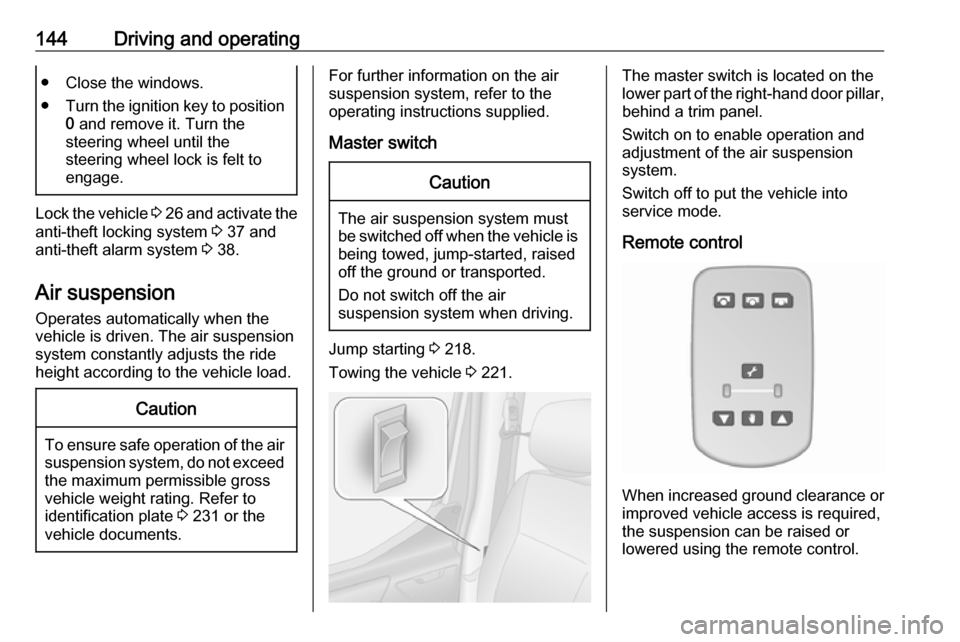
144Driving and operating● Close the windows.
● Turn the ignition key to position
0 and remove it. Turn the
steering wheel until the
steering wheel lock is felt to
engage.
Lock the vehicle 3 26 and activate the
anti-theft locking system 3 37 and
anti-theft alarm system 3 38.
Air suspension
Operates automatically when the
vehicle is driven. The air suspension
system constantly adjusts the ride
height according to the vehicle load.
Caution
To ensure safe operation of the air
suspension system, do not exceed the maximum permissible gross
vehicle weight rating. Refer to
identification plate 3 231 or the
vehicle documents.
For further information on the air
suspension system, refer to the
operating instructions supplied.
Master switchCaution
The air suspension system must
be switched off when the vehicle is being towed, jump‐started, raised
off the ground or transported.
Do not switch off the air
suspension system when driving.
Jump starting 3 218.
Towing the vehicle 3 221.
The master switch is located on the
lower part of the right-hand door pillar,
behind a trim panel.
Switch on to enable operation and
adjustment of the air suspension
system.
Switch off to put the vehicle into
service mode.
Remote control
When increased ground clearance or improved vehicle access is required,
the suspension can be raised or
lowered using the remote control.
Page 147 of 251
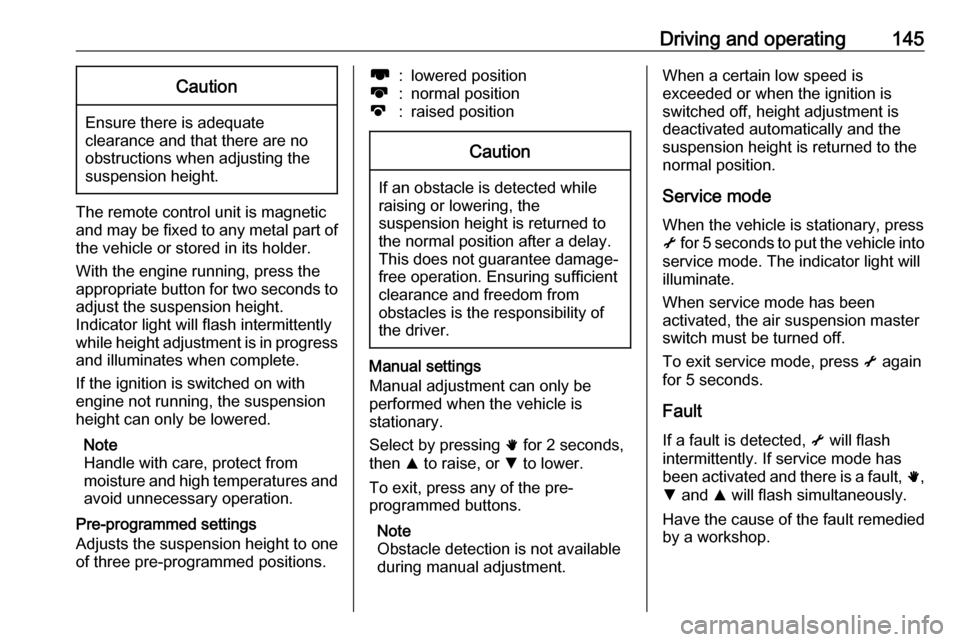
Driving and operating145Caution
Ensure there is adequate
clearance and that there are no
obstructions when adjusting the
suspension height.
The remote control unit is magnetic
and may be fixed to any metal part of the vehicle or stored in its holder.
With the engine running, press the appropriate button for two seconds to
adjust the suspension height.
Indicator light will flash intermittently
while height adjustment is in progress
and illuminates when complete.
If the ignition is switched on with
engine not running, the suspension
height can only be lowered.
Note
Handle with care, protect from
moisture and high temperatures and
avoid unnecessary operation.
Pre-programmed settings
Adjusts the suspension height to one
of three pre-programmed positions.
l:lowered positionk:normal positionj:raised positionCaution
If an obstacle is detected while
raising or lowering, the
suspension height is returned to the normal position after a delay.
This does not guarantee damage- free operation. Ensuring sufficient
clearance and freedom from
obstacles is the responsibility of the driver.
Manual settings
Manual adjustment can only be
performed when the vehicle is
stationary.
Select by pressing h for 2 seconds,
then R to raise, or S to lower.
To exit, press any of the pre-
programmed buttons.
Note
Obstacle detection is not available
during manual adjustment.
When a certain low speed is
exceeded or when the ignition is
switched off, height adjustment is deactivated automatically and the
suspension height is returned to the
normal position.
Service mode
When the vehicle is stationary, press
i for 5 seconds to put the vehicle into
service mode. The indicator light will
illuminate.
When service mode has been
activated, the air suspension master
switch must be turned off.
To exit service mode, press i again
for 5 seconds.
Fault
If a fault is detected, i will flash
intermittently. If service mode has been activated and there is a fault, h,
S and R will flash simultaneously.
Have the cause of the fault remedied
by a workshop.
Page 203 of 251
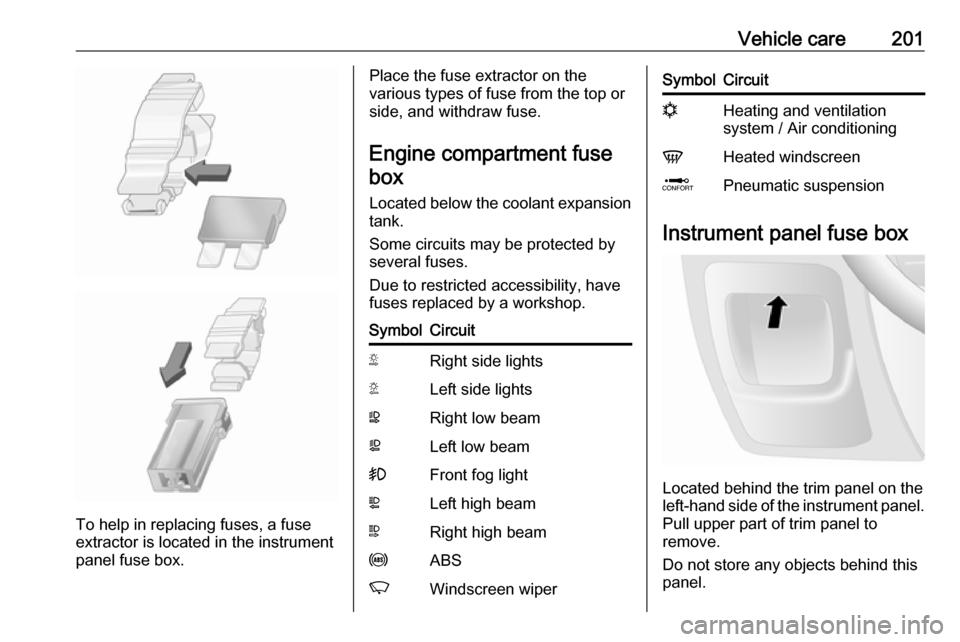
Vehicle care201
To help in replacing fuses, a fuse
extractor is located in the instrument
panel fuse box.
Place the fuse extractor on the
various types of fuse from the top or
side, and withdraw fuse.
Engine compartment fusebox
Located below the coolant expansion tank.
Some circuits may be protected by
several fuses.
Due to restricted accessibility, have
fuses replaced by a workshop.SymbolCircuitSRight side lightsTLeft side lightsWRight low beamaLeft low beam>Front fog lightLLeft high beamNRight high beamuABSKWindscreen wiperSymbolCircuitnHeating and ventilation
system / Air conditioningVHeated windscreenQPneumatic suspension
Instrument panel fuse box
Located behind the trim panel on the
left-hand side of the instrument panel.
Pull upper part of trim panel to
remove.
Do not store any objects behind this
panel.
Page 216 of 251
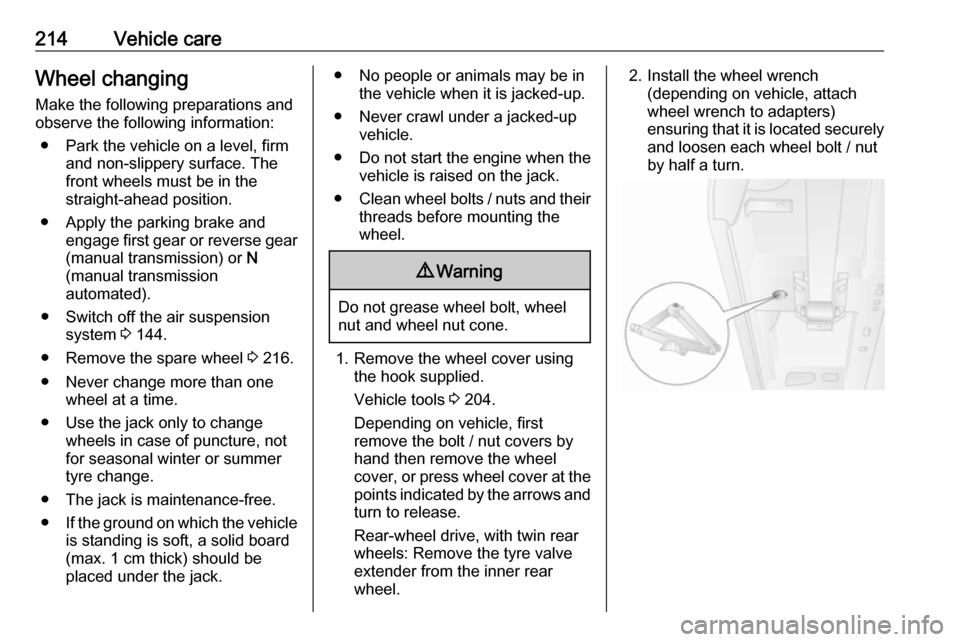
214Vehicle careWheel changingMake the following preparations and
observe the following information:
● Park the vehicle on a level, firm and non-slippery surface. The
front wheels must be in the
straight-ahead position.
● Apply the parking brake and engage first gear or reverse gear(manual transmission) or N
(manual transmission
automated).
● Switch off the air suspension system 3 144.
● Remove the spare wheel 3 216.
● Never change more than one wheel at a time.
● Use the jack only to change wheels in case of puncture, not
for seasonal winter or summer
tyre change.
● The jack is maintenance-free.
● If the ground on which the vehicle
is standing is soft, a solid board
(max. 1 cm thick) should be
placed under the jack.● No people or animals may be in the vehicle when it is jacked-up.
● Never crawl under a jacked-up vehicle.
● Do not start the engine when the vehicle is raised on the jack.
● Clean wheel bolts / nuts and their
threads before mounting the
wheel.9 Warning
Do not grease wheel bolt, wheel
nut and wheel nut cone.
1. Remove the wheel cover using the hook supplied.
Vehicle tools 3 204.
Depending on vehicle, first
remove the bolt / nut covers by
hand then remove the wheel
cover, or press wheel cover at the points indicated by the arrows and
turn to release.
Rear-wheel drive, with twin rear
wheels: Remove the tyre valve
extender from the inner rear
wheel.
2. Install the wheel wrench (depending on vehicle, attach
wheel wrench to adapters)
ensuring that it is located securely and loosen each wheel bolt / nutby half a turn.
Page 221 of 251
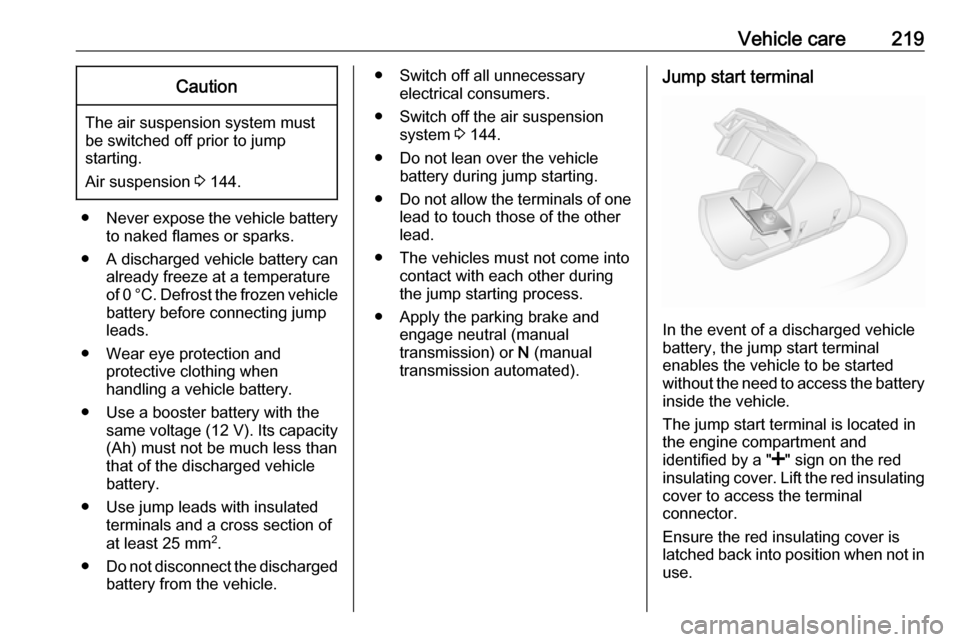
Vehicle care219Caution
The air suspension system must
be switched off prior to jump
starting.
Air suspension 3 144.
● Never expose the vehicle battery
to naked flames or sparks.
● A discharged vehicle battery can already freeze at a temperature
of 0 °C. Defrost the frozen vehicle
battery before connecting jump leads.
● Wear eye protection and protective clothing when
handling a vehicle battery.
● Use a booster battery with the same voltage (12 V). Its capacity(Ah) must not be much less than
that of the discharged vehicle
battery.
● Use jump leads with insulated terminals and a cross section of
at least 25 mm 2
.
● Do not disconnect the discharged
battery from the vehicle.
● Switch off all unnecessary electrical consumers.
● Switch off the air suspension system 3 144.
● Do not lean over the vehicle battery during jump starting.
● Do not allow the terminals of one
lead to touch those of the other
lead.
● The vehicles must not come into contact with each other during
the jump starting process.
● Apply the parking brake and engage neutral (manual
transmission) or N (manual
transmission automated).Jump start terminal
In the event of a discharged vehicle
battery, the jump start terminal
enables the vehicle to be started
without the need to access the battery inside the vehicle.
The jump start terminal is located in
the engine compartment and
identified by a " <" sign on the red
insulating cover. Lift the red insulating
cover to access the terminal
connector.
Ensure the red insulating cover is
latched back into position when not in
use.
Page 223 of 251
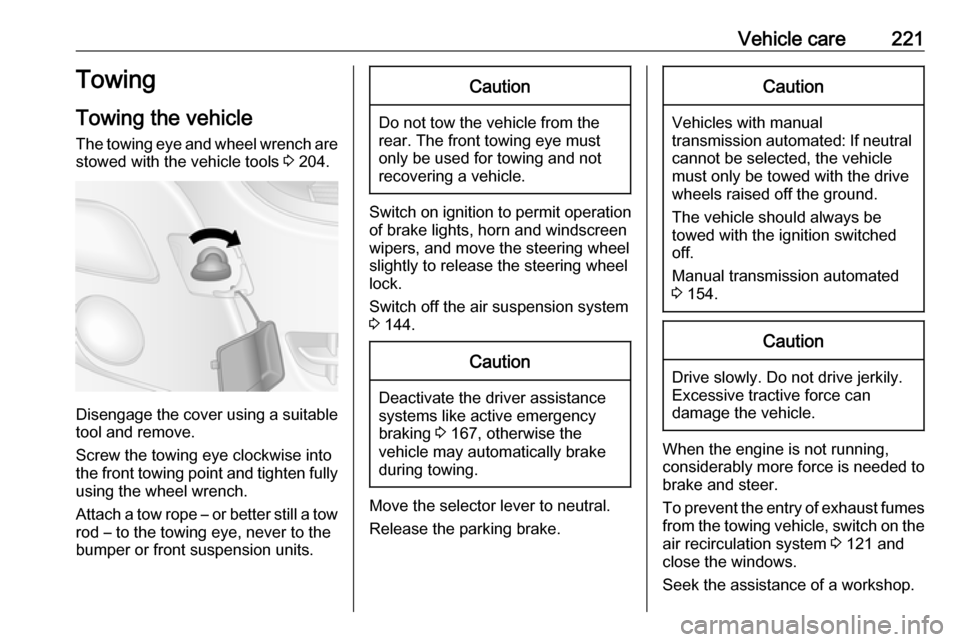
Vehicle care221Towing
Towing the vehicle The towing eye and wheel wrench are stowed with the vehicle tools 3 204.
Disengage the cover using a suitable
tool and remove.
Screw the towing eye clockwise into
the front towing point and tighten fully using the wheel wrench.
Attach a tow rope – or better still a tow
rod – to the towing eye, never to the
bumper or front suspension units.
Caution
Do not tow the vehicle from the
rear. The front towing eye must
only be used for towing and not
recovering a vehicle.
Switch on ignition to permit operation
of brake lights, horn and windscreen
wipers, and move the steering wheel
slightly to release the steering wheel
lock.
Switch off the air suspension system 3 144.
Caution
Deactivate the driver assistance
systems like active emergency
braking 3 167, otherwise the
vehicle may automatically brake during towing.
Move the selector lever to neutral.
Release the parking brake.
Caution
Vehicles with manual
transmission automated: If neutral cannot be selected, the vehiclemust only be towed with the drive
wheels raised off the ground.
The vehicle should always be
towed with the ignition switched
off.
Manual transmission automated
3 154.
Caution
Drive slowly. Do not drive jerkily.
Excessive tractive force can
damage the vehicle.
When the engine is not running,
considerably more force is needed to
brake and steer.
To prevent the entry of exhaust fumes
from the towing vehicle, switch on the air recirculation system 3 121 and
close the windows.
Seek the assistance of a workshop.
Page 224 of 251
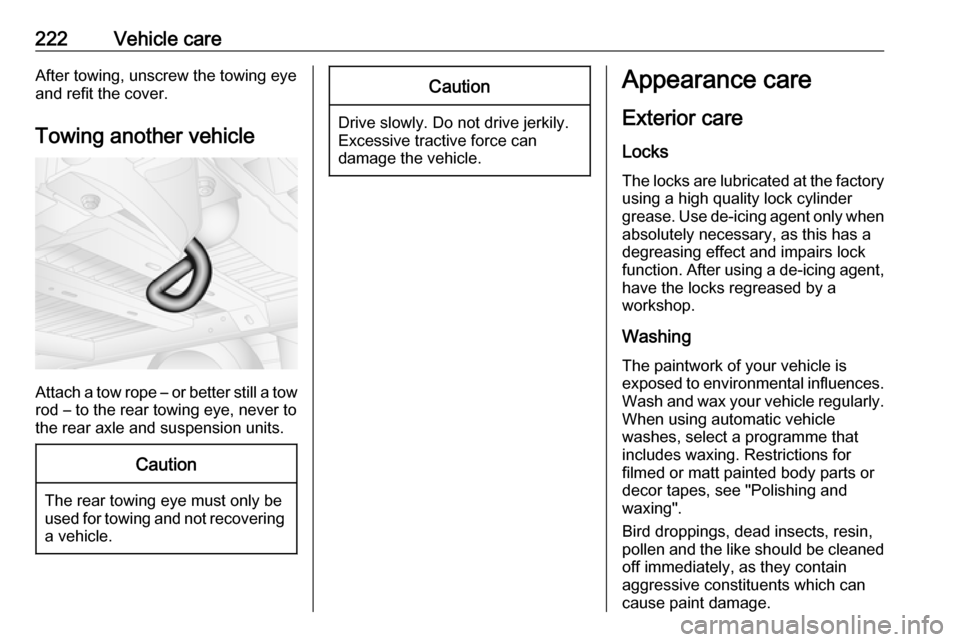
222Vehicle careAfter towing, unscrew the towing eyeand refit the cover.
Towing another vehicle
Attach a tow rope – or better still a tow
rod – to the rear towing eye, never to
the rear axle and suspension units.
Caution
The rear towing eye must only be
used for towing and not recovering a vehicle.
Caution
Drive slowly. Do not drive jerkily.
Excessive tractive force can
damage the vehicle.
Appearance care
Exterior care Locks
The locks are lubricated at the factory using a high quality lock cylinder
grease. Use de-icing agent only when absolutely necessary, as this has a
degreasing effect and impairs lock function. After using a de-icing agent,
have the locks regreased by a
workshop.
WashingThe paintwork of your vehicle is
exposed to environmental influences.
Wash and wax your vehicle regularly.
When using automatic vehicle
washes, select a programme that
includes waxing. Restrictions for
filmed or matt painted body parts or
decor tapes, see "Polishing and
waxing".
Bird droppings, dead insects, resin,
pollen and the like should be cleaned
off immediately, as they contain
aggressive constituents which can
cause paint damage.
Page 244 of 251

242IndexAAbsorptive Glass Mat battery .....187
Accessories and vehicle modifications .......................... 181
Active emergency braking ..105, 167
AdBlue ........................ 103, 147, 228
AdBlue gauge ............................... 95
AdBlue tank ................................ 232
Adjustable air vents ...................133
Airbag and belt tensioners .........100
Airbag deactivation ..............65, 100
Airbag label................................... 61 Airbag system .............................. 61
Air conditioning regular operation ................................ 134
Air conditioning system .............. 121
Air intake .................................... 134
Air suspension ........................... 144
Air suspension system................ 221
Air vents...................................... 133
Antifreeze ................................... 185
Antilock brake system ................ 158
Antilock brake system (ABS) .....102
Anti-theft alarm system ................38
Anti-theft bolts............................. 214
Anti-theft locking system .............. 37
Anti-theft security lock ..................25
Appearance care ........................222
Armrest ........................................ 53
Ashtrays ....................................... 93Automatic light control ...............112
Automatic locking ...................26, 31
Autostop ....................... 19, 139, 140
Auxiliary heater ........................... 127
B Battery .................... 23, 24, 127, 187
Battery discharge protection ......119
Battery, jump starting.................. 218
Belts.............................................. 57 Bonnet ....................................... 182
Bottle holders................................ 77
Brake assist ............................... 160
Brake fluid .......................... 187, 228
Brakes ............................... 158, 187
Brake system ............................. 102
Breakdown.................................. 221
Bulb replacement ....................... 191
Bus Rear seats ................................. 54
C Cabin bulkhead grille ....................83
Capacities .................................. 232
Cargo management system ........80
Car Pass ...................................... 23
Catalytic converter .....................146
Central locking system ................26
Centre high-mounted brake light 197
Changing tyre and wheel size ...210
Charging system ........................ 101
Page 248 of 251

246Reversing lights .........................116
Ride control systems ..........160, 163
Ride height ................................. 144
Roof .............................................. 46
Glass panel ............................... 46
Roof load ...................................... 85
Roof rack ..................................... 85
S Safety belts ................................... 57
Safety net .................................... 83
Seat adjustment ....................... 7, 49
Seat belt ........................................ 8
Seat belt reminder .....................100
Seat belts ..................................... 57
Seat heating ................................. 54
Seat position ................................ 48
Selective catalytic reduction .......147
Selector lever ............................. 155
Service ............................... 134, 226
Service display ....................96, 101
Service information ....................226
Service vehicle soon .................. 101
Side airbag system ......................65
Sidelights .................................... 112
Side turn lights ........................... 196
Side windows................................ 44
Sliding door .................................. 32
Sliding side door ........................... 32
Spare wheel ............................... 216Speed limiter ................93, 106, 165
Speedometer ............................... 93
Starting and operating ................138
Starting off ................................... 19
Starting the engine .......19, 139, 155
Steering ...................................... 137
Steering column controls ..............88
Steering wheel adjustment ....10, 88
Steering wheel controls ...............88
Stop engine ................................ 102
Stop-start system.......... 19, 105, 140
Storage ......................................... 76
Storage compartments .................76
Storage net ............................. 77, 78
Sun visors .................................... 45
Suspension height ......................144
Suspension seat ........................... 49
Swivelling shelf ............................. 77
Symbols ......................................... 4
T
Tachograph ........................ 106, 111
Tachometer ................................. 94
Tail lights ................................... 195
Three-point seat belt .................... 58 Tools .......................................... 204
Top-Tether .................................... 67
Touchscreen ............................... 107
Tow bar....................................... 177
Towing ........................................ 177Towing another vehicle .............222
Towing a trailer ........................... 177
Towing equipment .....................178
Towing eye ................................. 221
Towing the vehicle .....................221
Traction Control system ............. 160
Trailer coupling ........................... 177
Trailer stability assist .................178
Trailer towing ............................. 177
Transmission ............................... 18
Transmission display ...........97, 154
Tread depth ............................... 209
Trip computer ............................ 109
Trip odometer .............................. 94
Turbo engine warm-up ...............139
Turn lights .......................... 100, 115
Tyre chains ................................ 210
Tyre changing ............................. 214
Tyre designations ......................206
Tyre pressure ............................ 206
Tyre pressure monitoring system ............................. 104, 207
Tyre pressures ........................... 233
Tyre repair kit ............................. 211
Tyres .......................................... 205
Tyres and wheel size, changing. 210
U Ultrasonic parking assist............. 169
Underseat storage .......................78